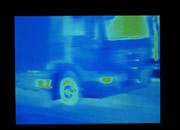Jun 15 2010
Siemens is focusing on new technology development for reducing the consequences or risk of a tunnel fire. It has created a system that is able to detect truck components that have heated up, like brakes, before the vehicle approaches the channel and delivers an alarm for potential danger. This information is available in the next edition of the ‘Pictures of the Future’ magazine.
Information related to the contents of the truck that is transporting hazardous substances is gathered by an RFID system before it approaches the tunnel and transmitted to the control center of the tunnel to warn the fire department that has to cater for the fire event. The testing of this system commenced in May 2010 at the Aubinger Tunnel located near Munich, Germany.
 Siemens Aubinger Tunnel near Munich, Germany testing the system
Siemens Aubinger Tunnel near Munich, Germany testing the system
Defective vehicles are the most frequent cause of tunnel fires, with the damage being severe due to truck accident. For this reason only certain tunnels are allowed to pass trucks loaded with hazardous goods.
The trucks carry a placard that has information related to the load’s hazardous nature, as well as the permitted tunnel category permitted. Video cameras installed in the tunnel utilize this placard to find out if the vehicle can be allowed to pass.
The system utilizes a combination of thermal and video thermal imaging for finding out if particular truck components like engine, brakes or wheels, are overheated dangerously. Image processing software initially detects the recorded vehicle like a truck.
The truck’s model is then generated by the program along with marking of the truck parts for checking. The thermal and video images are overlaid by the software. The overheated truck components are then identified by referring to data on allowed temperature distribution between the parts.
Since the placards placed on the hazardous goods transport trucks are scarcely readable during poor weather, the researchers created RFID tags for transmission of precise information related to the load by a reader installed before the tunnel.
This data uses special algorithms for querying even when the truck is moving full speed. The system utilizes battery-based, active RFID tags to cover the requisite 50 meters range. For saving energy, the activation of the tags only take place on the readers’ prompts. Accordingly the communications protocol has been optimized by the developers. Siemens had developed a crypto-chip that can prevent the interception and the modification of the data transmitted. The chip has low power consumption and fast data transfer capabilities.